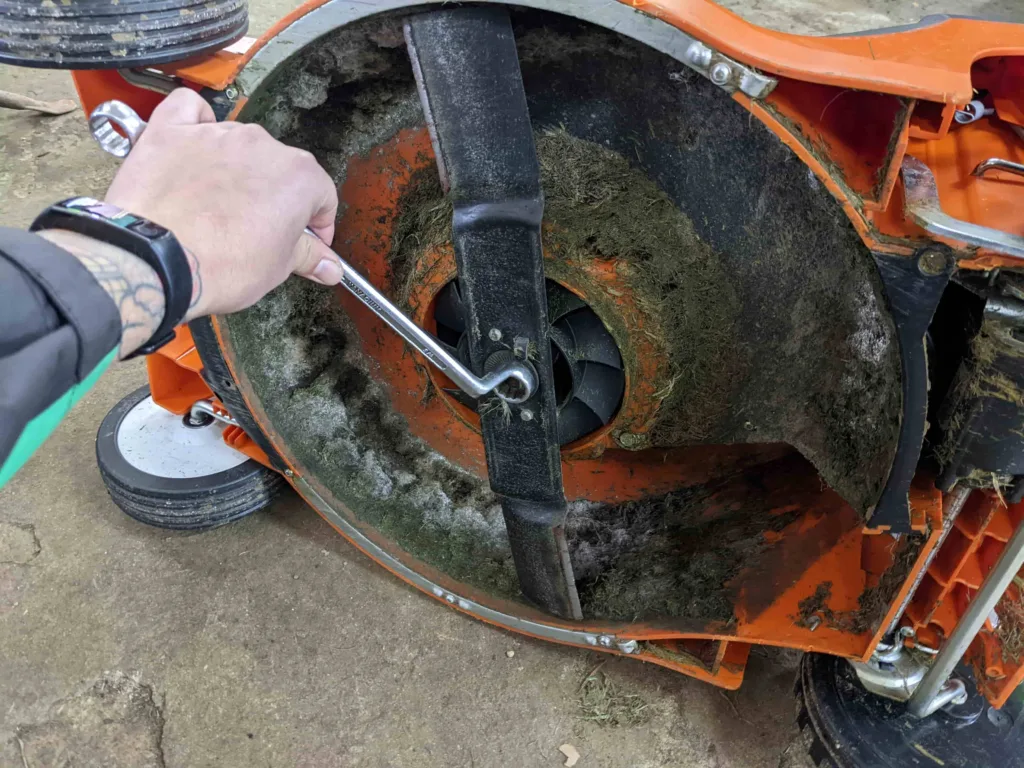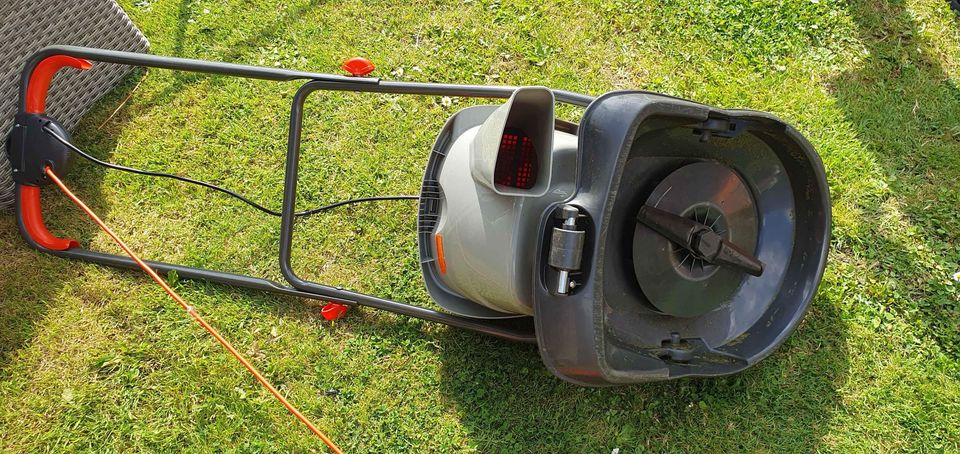If you want to get the cleanest, highest-quality cut from your lawn mower year after year, you will need to occasionally sharpen the blade.
Here, we’ve shared the simple step-by-step process for safely sharpening a lawn mower blade (using UK terminology).
✅Key Takeaways:
Sharpening your lawn mower’s blade will allow the blade to produce a clean cut that won’t rip or tear your grass.
To sharpen lawn mower blades, follow these steps:
Gather your tools and materials
Remove the blade
Sharpen the blade with a sharpening tool
Check the blade balance
Reattach the blade
You should sharpen your blade once or twice per year, or whenever you notice that the blade is dull.
Table of Contents
🤷♂️ What’s The Best Lawn Mower Blade Sharpener?
There are a few different ways to sharpen a lawn mower blade.
We recommend using a dedicated blade sharpening tool because it offers the most effective results with the least amount of effort. Dedicated sharpening tools also typically have safety features that a more basic piece of equipment, like a sharpening stone, may not have.
The SHARPAL 103N All-in-1 Knife and Garden Tool Blade Sharpener is a popular lawn mower sharpening tool in the UK, with positive ratings from more than 9,000 users. It has an oversized handle for safe, comfortable use, and works quickly to sharpen lawn mower blades in less than 5 minutes.
🧰 How To Sharpen Lawn Mower Blades: Step-By-Step
Follow these steps to quickly and safely sharpen your lawn mower’s blade.
🛠 Step 1: Gather Your Tools & Materials
First, gather all the tools and materials you’ll need to sharpen the blade.
You’ll need:
A clamp or a vice
Rags
A ratchet or socket set/ a spanner
Safety gloves
Safety goggles
Your blade sharpener of choice
Prepare your tools and materials for use. Ideally, you want to be outdoors or in a dedicated work space (like a garage, shed, or outhouse) for this job.
It’s essential that you have a sturdy vice to clamp the blade while you’re sharpening it. Don’t take the risk and simply hold the blade between your feet – that’s an accident waiting to happen.
Don’t have a bench vice? You can buy one on Amazon for less than £20. We recommend the Stanley 1-83-069 MAXSTEEL Multi Angle Vice because it’s the cheapest high-quality vice with great customer reviews.

✂️ Step 2: Remove The Blade
Next, remove your lawn mower’s blade.
Your will need to follow specific steps outlined in your user manual for this job. The process of disassembling your mower and removing the blade depends on the mower type (petrol vs electric mower etc.) and manufacturer.
For a petrol lawn mower, the general process is this:
Remove the spark plug and tape back the spark plug wire to stop it from slipping back into the plug.
Put the mower on its side, with the air filter pointing upwards. This will prevent petrol and oil from dripping into the filter.
Mark the top of the blade with a marker pen so you know which side of the blade is top and which is bottom when you reattach it to the mower (this isn’t necessary for mowers with a reversible blade).
Clamp the blade, then use a socket set or spanner to remove the bolt holding the blade in place.
Put the mower back onto all four wheels until you’ve sharpened the blade.
Make sure to read your user instructions carefully and follow all the safety precautions outlined by the manufacturer.

🔪 Step 3: Sharpen The Blade With A Blade Sharpener
Now it’s time to sharpen the blade.
There are a few different items that you can use to sharpen the cutting edge, including an angle grinder or bench grinder, a drill’s grinding wheel, a file, or a belt grinder.
Here, we’ve outlined how to sharpen the blade with a dedicated blade sharpener or file.
Put on a pair of safety gloves and safety goggles, then clamp the blade in your table vice, with the cutting edge pointing up to the ceiling.
Drag the sharpener diagonally along the blade edges, starting from one side and finishing at the other. You’ll need to make around 50 strokes to sharpen the blades on a conventional domestic mower.
Once you’ve finished, the blade should be about as sharp as a butter knife.
Out top tip: Make sure you have the correct angle for filing. File from the top side of the blade, in the same direction as the original cutting angle. You should feel resistance as you drag the file along the blade edge.

⚖️ Step 4: Check The Blade Balance
Before you put the blade back on the mower, make sure the blade balance is right.
Hang the blade on a nail or hook. It should hang horizontally, so if one of the sides dips, you’ve got an unbalanced blade.
To solve this issue, clamp the blade again and file off more of the side that dipped, then try hanging it from a nail again.
Don’t ignore an unbalanced blade – using it in your mower could cause vibrations that damage the bearings or blade shaft.
✂️ Step 5: Reattach The Blade
Now your blade is sharpened, put the mower on its side and attach the blade back onto the machine. Use the same long-handled spanner to tighten the bolt, securing the blade in place.
You’re now ready to start mowing once more – hopefully with a perfectly sharp blade!

🔧 How To Sharpen Lawn Mower Blades: Video
More of a visual learner?
This 1-minute video by Bosch shows you quickly and clearly how to sharpen the blade on a rotary lawn mower using a Dremel rotary tool with a sharpening kit.
🗓 How Often Should You Sharpen Lawnmower Blades?
You should sharpen your lawn mower blade about once or twice per season, or whenever you notice that your blade is blunt.
There are a few factors that affect how often you’ll need to get your lawn mower blades sharpened, including:
The size of your mowing space – The bigger the lawn, the more action the blades see with every mowing session, and the faster they’ll become worn and dull.
The frequency that you mow your lawn – The more often you mow your lawn, the more use you’ll get out of the lawnmower blade, and the more often it’ll need sharpening.
The quality of the blade – High-quality, sturdy blades are likely to be more durable and less prone to becoming dull and blunt than thinner, flimsier blades.
The mowing terrain – If you regularly mow long, thick grass or lawns with lots of debris, like leaves and twigs, your blades will become dull at a faster rate than if you only mow mid-length, sparser grass with no debris.
Let’s look at how often you should sharpen lawn mower blades depending on the mower type:
How Often To Sharpen Cylinder Blades
Sharpen your lawn mower’s cylinder blades once or twice during a mowing season, or whenever you notice a decrease in the quality of cut.
Cylinder blades consist of several vertically spinning blades. They’re smaller and thinner than rotary blades, which means they provide a neater, cleaner cut – but they also become dull at a faster rate.
You may be able to sharpen your cylinder mower’s blades yourself, or you might prefer to ask your local mower dealer or garden maintenance company to sharpen the blades for you.
How Often To Sharpen Rotary Blades
Ideally, a rotary mower blade should be sharpened at least once a season, or after around 25 hours of use.
Depending on the size of your lawn, you might be able to use a rotary mower for a couple of years before the blade needs sharpening.
Rotary mowers have a single large, sturdy blade that rotates horizontally, cutting grass with a “smashing” action.
This powerful blade should do a good job of cutting your grass regardless of its sharpness, but you should still sharpen the blade occasionally to prevent unnecessary damage to your grass leaves.

🌱🚑 Why Sharpen Your Lawn Mower Blades?
Sharpening your lawn mower’s blade is essential if you want to continue to neatly and cleanly cut your grass throughout your mower’s lifespan.
To understand why we should sharpen lawn mower blades, let’s think about what happens to another sharp object – a knife – with regular use.
When freshly sharpened, a knife cuts cleanly through even the toughest fruits, veggies, and meats.
But when a knife has been dulled over time with use, the blade will struggle to provide the same clean cut, and requires more effort from you to do the same job.
The same applies to cutting grass with a lawn mower blade. When the blade is sharp, it’ll provide a clean cut, neatly snipping the ends of your grass blades. The grass is able to recover more quickly as a result.
But when the blade is dull, it’ll pull and rip your grass, tearing the ends, which could stress and weaken the leaf. Blunt blades also put more stress on the mower because the motor has to work harder to provide enough power to spin the blades, which face more resistance from the grass.
Failing to sharpen your lawn mower blades routinely may cause your grass to become yellow, and puts the grass leaves at greater risk of disease.
Poor cut quality

Good cut quality


♻️ Sharpening Vs Replacing Lawn Mower Blades
So, when should you sharpen your lawn mower blade, and when should you replace your blade with a new one?
Nine times out of ten, you should be able to sharpen your blade to extend its lifespan, without needing a new blade.
If your blades are simply blunt, don’t waste money on new materials. Sharpening the blades will bring them back to like-new condition and restore their cutting capabilities.
However, there are a few occasions when you may need to replace your lawn mower blade rather than sharpen it. These include:
If the blade is rusty or corroded
If the blade is cracked, chipped, or bent
If the blade’s edge has become worn down, thin, and flimsy
If you have a specific mower that doesn’t have reusable blades, such as a robot mower
If in doubt, contact your manufacturer. They’ll be able to advise you on how best to remedy a blunt blade problem – ideally without having to spend money on a new blade.

🏁 Final Word
Sharpening your mower blade is an essential mower maintenance task.
A sharp blade will provide a neater, cleaner cut, helping you to sustain a healthier lawn with a reduced risk of grass diseases. Dull blades, on the other hand, are more likely to shred and tear your grass, resulting in brown edges and a higher likelihood of moss and disease.
Hopefully, you’ve now learned everything you needed to know about sharpening your lawn mower’s blade. Feel free to contact us if you have any more questions – and happy mowing!

